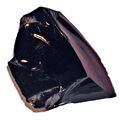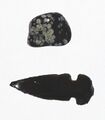- v50 information can now be added to pages in the main namespace. v0.47 information can still be found in the DF2014 namespace. See here for more details on the new versioning policy.
- Use this page to report any issues related to the migration.
Difference between revisions of "v0.34:Obsidian"
m (clarify) |
m (links) |
||
| Line 1: | Line 1: | ||
{{layerlookup/0}}{{av}}{{Quality|Exceptional|21:08, 8 June 2010 (UTC)}} | {{layerlookup/0}}{{av}}{{Quality|Exceptional|21:08, 8 June 2010 (UTC)}} | ||
| − | '''Obsidian''' is one of the types of "[[stone]]" (technically volcanic glass) that forms entire [[Stone#Stones forming entire layers|layer]]s. Obsidian is also found surrounding magma pools and volcanoes, exactly 1 tile thick, and has the distinction of being the only stone that can be [[obsidian farming|created during play]]. Obsidian is considered an [[ | + | '''Obsidian''' is one of the types of "[[stone]]" (technically volcanic glass) that forms entire [[Stone#Stones forming entire layers|layer]]s. Obsidian is also found surrounding magma pools and volcanoes, exactly 1 tile thick, and has the distinction of being the only stone that can be [[obsidian farming|created during play]]. Obsidian is considered an [[Economic stones|economic stone]] by default; in order to allow general use at workshops and in architecture you must enable "obsidian" in the [[stocks]] "Stone" menu. |
"Obsidian" is also the twelfth month of the dwarven [[calendar]], covering late Winter. | "Obsidian" is also the twelfth month of the dwarven [[calendar]], covering late Winter. | ||
Revision as of 19:58, 30 May 2013
| ||||||||||||||||||||||||||||||||||||
| Uses | ||||||||||||||||||||||||||||||||||||
|---|---|---|---|---|---|---|---|---|---|---|---|---|---|---|---|---|---|---|---|---|---|---|---|---|---|---|---|---|---|---|---|---|---|---|---|---|
| Properties | ||||||||||||||||||||||||||||||||||||
| ||||||||||||||||||||||||||||||||||||
| Contains | ||||||||||||||||||||||||||||||||||||
| ||||||||||||||||||||||||||||||||||||
| This article is about an older version of DF. |
Obsidian is one of the types of "stone" (technically volcanic glass) that forms entire layers. Obsidian is also found surrounding magma pools and volcanoes, exactly 1 tile thick, and has the distinction of being the only stone that can be created during play. Obsidian is considered an economic stone by default; in order to allow general use at workshops and in architecture you must enable "obsidian" in the stocks "Stone" menu.
"Obsidian" is also the twelfth month of the dwarven calendar, covering late Winter.
Rock short sword
Obsidian can also be made into obsidian short swords with one log at the craftsdwarf's workshop. If you embark on an obsidian mountain or manage to reach magma before finding metallic ores, these are good at first to defend your fort from early wolf and giant eagle attacks, but weak in comparison to any metal, having difficulty cutting even mundane animal hides. Note that with the use of wood (presumably used in the handle), Elves will be be offended if you trade obsidian swords and refuse the trade.
Obsidian is the only rock that can be used to make stone-based weapons.
Obsidian formation
Obsidian can be formed by mixing water and magma. Any tiles containing both water and magma will be replaced with unmined obsidian, generating abundant amounts of steam. When dumping water via a pond zone onto magma, the water has to fall free for at least one z-level (i.e. the pond zone must be two or more z-levels above the magma); otherwise only steam will be produced.
Most non-magma-safe objects that were in the magma prior to the formation of obsidian are completely destroyed, which can be an effective method of removing unwanted items or enemies, although long exposure times to magma are suggested to ensure destruction. All magma-safe items will be entombed in the tile, and can be regained by mining it along with any magma-unsafe items that happened to survive the casting process. No instances of globs of molten metal surviving obsidian formation have been noted, though apparently burning objects can remain on fire when cast in obsidian. The survival rate of magma-unsafe items is believed to depend on the exposure time to magma being short enough to not cause the item in question to melt or burn before obsidian formation occurs--fragile items placed in water that is then exposed to magma tend to survive casting unscathed.
Obsidian farming can be used to produce large amounts of obsidian for masonry, crafting, or construction.
[INORGANIC:OBSIDIAN]
[USE_MATERIAL_TEMPLATE:STONE_TEMPLATE]
[MELTING_POINT:13600]
[BOILING_POINT:16000]
[STATE_NAME_ADJ:ALL_SOLID:obsidian][DISPLAY_COLOR:0:7:1][TILE:177][LAVA]
[MAX_EDGE:20000]
[IGNEOUS_EXTRUSIVE]
[MATERIAL_VALUE:3]
[IS_STONE]
MELTING_POINT:11818 <-- I think this is from the data collected by the contributors above and is more accurate than the numbers we're using, but we're using a high melting point until environmental lava effects are further along.
[SOLID_DENSITY:2650] |
| Sedimentary | |||||
|---|---|---|---|---|---|
| Igneous |
| ||||
| Metamorphic | |||||
| Ore | |||||
| Economic | |||||
| Other |
Alunite · Anhydrite · Bauxite · Borax · Brimstone · Chromite · Cinnabar · Cobaltite · Cryolite · Graphite · Hornblende · Ilmenite · Jet · Kimberlite · Marcasite · Mica · Microcline · Olivine · Orpiment · Orthoclase · Periclase · Petrified wood · Pitchblende · Puddingstone · Pyrolusite · Realgar · Rutile · Saltpeter · Serpentine · Slade · Stibnite · Sylvite · Talc | ||||



